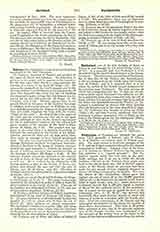

Nathinites, or NATHINEANS (Hebrew: HNTYNYM, the given ones; LXX generally of Greek: oi Natheinim once [I Chron., ix, 2] of oi dedomenoi an inferior class of Temple servants. The name occurs in seventeen passages of the O. T., and the Vulgate renders it always by the adapted transcription Nathinoei. Josephus (Ant. of the Jews, xi, i, 6) renders the Hebrew Nethinim by the equivalent Greek: ierodouloi, i.e. “sacred servants”. The Nathinites appear under this title only in the post-Exilic writings, but if we are to credit the Jewish tradition reflected in the Talmud, their origin goes back to the time of Josue, viz.: that in the first organization of the Mosaic ritual no provision had been made for the menial services regularly deputed to slaves—all being performed by the levites. But after the defeat of the Madianites, Moses gave (Hebrew: NTN nathan) one out of every 50 of the 16,000 prisoners (320 in all) to the levites for the service of the Tabernacle at night (Num., xxxi, 47). Josue, however, it is claimed, was the first to officially depute a number of slaves for the exclusive service of the sanctuary. Out of respect for his oath he spared the lives of the Gabaonites (Jos., ix, 23, 26-27), but decreed that henceforth they must become hewers of wood and drawers of water in connection with the Jewish worship. After the construction of the Temple and the consequent development of the ritual, the number of these slaves was increased. They were in all probability prisoners of war, who in the growing organization of the Temple worship were condemned to be the servants of the levites, even as the latter in the course of time had been differentiated from the priests. Though not of the Jewish race, it is probable that the Nathineans learned and practiced the Jewish religion. Nehemias (II Esd., x, 28) classes them with those who were separated from the people to serve the law of God, but according to the Talmud they were a despised class and were debarred from contracting marriage with Jewish women. They were carried into captivity with the others by Nabuchodonosor, and according to Esdras, 612 of them (including those called “the children of the servants of Solomon“) returned to Palestine: 392 with Zorobabel (I Esd., ii, 43-58; II Esd., vii, 47-60), and 220 with Esdras eighty years later (I Esd., viii, 20). After the return the Nathineans lived most likely as they had previously under the monarchy, some in the levitical cities (I Esd., ii, 70; II Esd., vii, 73), during the periods when they were not detailed for service in the Temple, the others in Jerusalem, where, as Nehemias informs us (II Esd., iii, 26, xi, 21), they inhabited the Ophel quarter, i.e. in the southeast part of the city, and near the gate leading to the fountain now known as the fountain of the Virgin. From this they drew the water of which copious use was made in the sacrificial and other sacred functions. They had officers chiefly chosen from among their own ranks (II Esdr., xi, 21; cf. I Esd., ii, 43; II Esd., vii, 47). Like the priests and levites they were exempted from taxation by the Persian rulers (I Esd., vii, 24). No mention or trace of the Nathineans appears in the New Testament.
JAMES F. DRISCOLL

